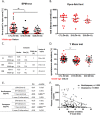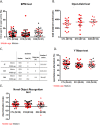Lack of direct involvement of a diazepam long-term treatment in the occurrence of irreversible cognitive impairment: a pre-clinical approach
- PMID: 34857741
- PMCID: PMC8640018
- DOI: 10.1038/s41398-021-01718-8
Lack of direct involvement of a diazepam long-term treatment in the occurrence of irreversible cognitive impairment: a pre-clinical approach
Abstract
Several observational studies have found a link between the long-term use of benzodiazepines and dementia, which remains controversial. Our study was designed to assess (i) whether the long-term use of benzodiazepines, at two different doses, has an irreversible effect on cognition, (ii) and whether there is an age-dependent effect. One hundred and five C57Bl/6 male mice were randomly assigned to the 15 mg/kg/day, the 30 mg/kg/day diazepam-supplemented pellets, or the control group. Each group comprised mice aged 6 or 12 months at the beginning of the experiments and treated for 16 weeks. Two sessions of behavioral assessment were conducted: after 8 weeks of treatment and after treatment completion following a 1-week wash-out period. The mid-treatment test battery included the elevated plus maze test, the Y maze spontaneous alternation test, and the open field test. The post-treatment battery was upgraded with three additional tests: the novel object recognition task, the Barnes maze test, and the touchscreen-based paired-associated learning task. At mid-treatment, working memory was impaired in the 15 mg/kg diazepam group compared to the control group (p = 0.005). No age effect was evidenced. The post-treatment assessment of cognitive functions (working memory, visual recognition memory, spatial reference learning and memory, and visuospatial memory) did not significantly differ between groups. Despite a cognitive impact during treatment, the lack of cognitive impairment after long-term treatment discontinuation suggests that benzodiazepines alone do not cause irreversible deleterious effects on cognitive functions and supports the interest of discontinuation in chronically treated patients.
© 2021. The Author(s).
Conflict of interest statement
The authors declare no competing interests.
Figures




Similar articles
-
Does concomitant diazepam and ethanol use modulate age-related cognitive decline in mice?Life Sci. 2024 Dec 15;359:123216. doi: 10.1016/j.lfs.2024.123216. Epub 2024 Nov 5. Life Sci. 2024. PMID: 39510169
-
Diazepam induces retrograde facilitation of object recognition and object location memory in male mice.Neuroreport. 2023 Feb 1;34(3):137-143. doi: 10.1097/WNR.0000000000001869. Epub 2022 Dec 27. Neuroreport. 2023. PMID: 36574287
-
Beneficial effects of ellagic acid against animal models of scopolamine- and diazepam-induced cognitive impairments.Pharm Biol. 2016 Oct;54(10):1947-53. doi: 10.3109/13880209.2015.1137601. Epub 2016 Feb 1. Pharm Biol. 2016. PMID: 26828763
-
Early cognitive changes due to whole body γ-irradiation: a behavioral and diffusion tensor imaging study in mice.Exp Neurol. 2013 Oct;248:360-8. doi: 10.1016/j.expneurol.2013.06.005. Epub 2013 Jun 11. Exp Neurol. 2013. PMID: 23769909
-
Spatial learning in the 5-HT1B receptor knockout mouse: selective facilitation/impairment depending on the cognitive demand.Learn Mem. 2003 Nov-Dec;10(6):466-77. doi: 10.1101/lm.60203. Learn Mem. 2003. PMID: 14657258 Review.
Cited by
-
The Atypical Dopamine Transporter Inhibitor CE-158 Enhances Dopamine Neurotransmission in the Prefrontal Cortex of Male Rats: A Behavioral, Electrophysiological, and Microdialysis Study.Int J Neuropsychopharmacol. 2023 Nov 24;26(11):784-795. doi: 10.1093/ijnp/pyad056. Int J Neuropsychopharmacol. 2023. PMID: 37725477 Free PMC article.
-
Drugs with a negative impact on cognitive functions (Part 2): drug classes to consider while prescribing in CKD patients.Clin Kidney J. 2023 Sep 18;16(12):2378-2392. doi: 10.1093/ckj/sfad239. eCollection 2023 Dec. Clin Kidney J. 2023. PMID: 38046029 Free PMC article. Review.
-
Benzodiazepine-induced anterograde amnesia: detrimental side effect to novel study tool.Front Pharmacol. 2023 Sep 14;14:1257030. doi: 10.3389/fphar.2023.1257030. eCollection 2023. Front Pharmacol. 2023. PMID: 37781704 Free PMC article. Review.
-
Long-term electroacupuncture and repetitive transcranial magnetic stimulation differentially slow the progression of Alzheimer's disease in AppNL-G-F mice.Alzheimers Res Ther. 2025 Jun 23;17(1):140. doi: 10.1186/s13195-025-01781-z. Alzheimers Res Ther. 2025. PMID: 40551158 Free PMC article.
-
Fall Outcomes in Older Adults Following Benzodiazepine/Z-Drug Discontinuation: A Retrospective Cohort Study in an Academic Health System.Drugs Aging. 2024 Oct;41(10):809-819. doi: 10.1007/s40266-024-01144-7. Epub 2024 Sep 18. Drugs Aging. 2024. PMID: 39292394
References
-
- Bordet R, Carton L, Deguil J, Dondaine T. Neuropsychopharmacologie. 2019. https://www.elsevier-masson.fr/neuropsychopharmacologie-9782294752995.ht.... Accessed Jan 2021.
-
- López-Pelayo H, Coma A, Gual A, Zara C, Lligoña A. Call for action: benzodiazepine prescription prevalence analysis shows off-label prescription in one in eleven citizens. Eur Addict Res. 2019;25:320–9. - PubMed
-
- Olfson M, King M, Schoenbaum M. Benzodiazepine use in the United States. JAMA Psychiatry. 2015;72:136–42. - PubMed
-
- Bénard-Laribière A, Pariente A. [Benzodiazepine use and misuse in France] Presse Med. 2018;47:878–81. - PubMed
-
- Agence nationale de sécurité du médicament et des produits de santé. Etat des lieux de la consommation des benzodiazépines en France. 2017. https://ansm.sante.fr/S-informer/Points-d-information-Points-d-informati.... Accessed Jan 2021.
MeSH terms
Substances
LinkOut - more resources
Full Text Sources

